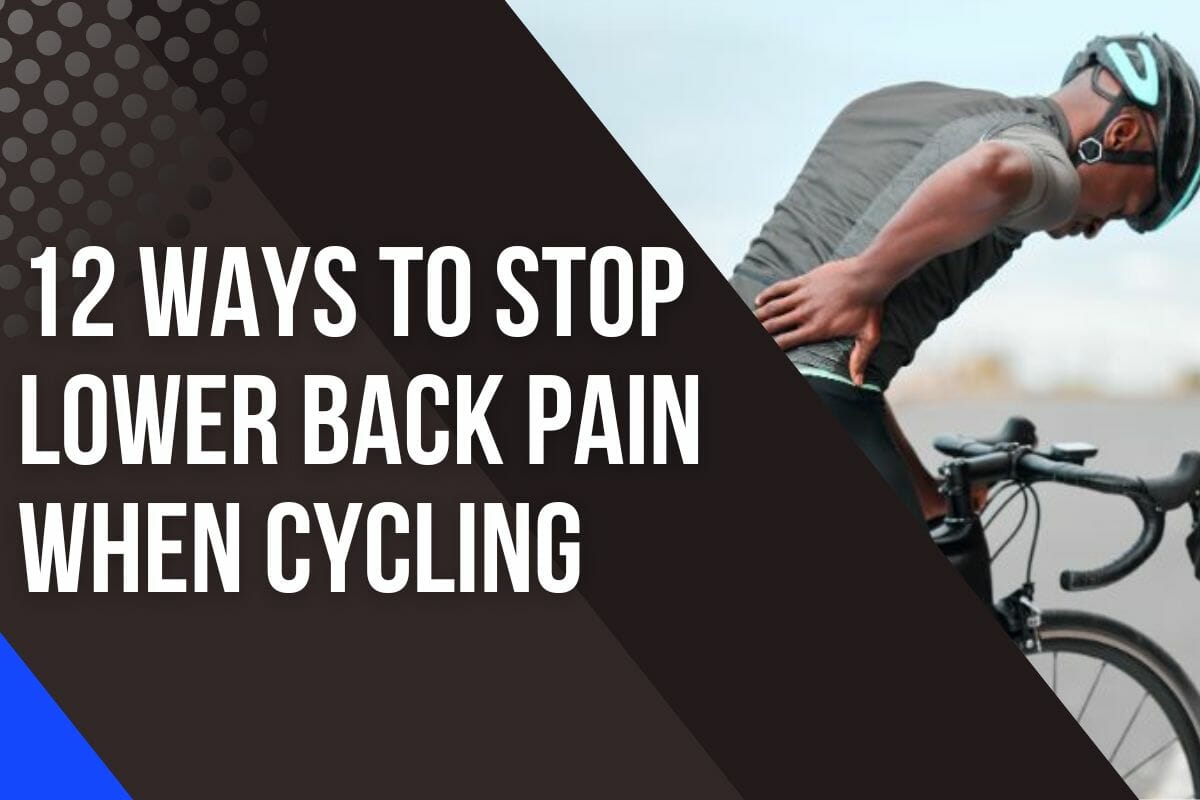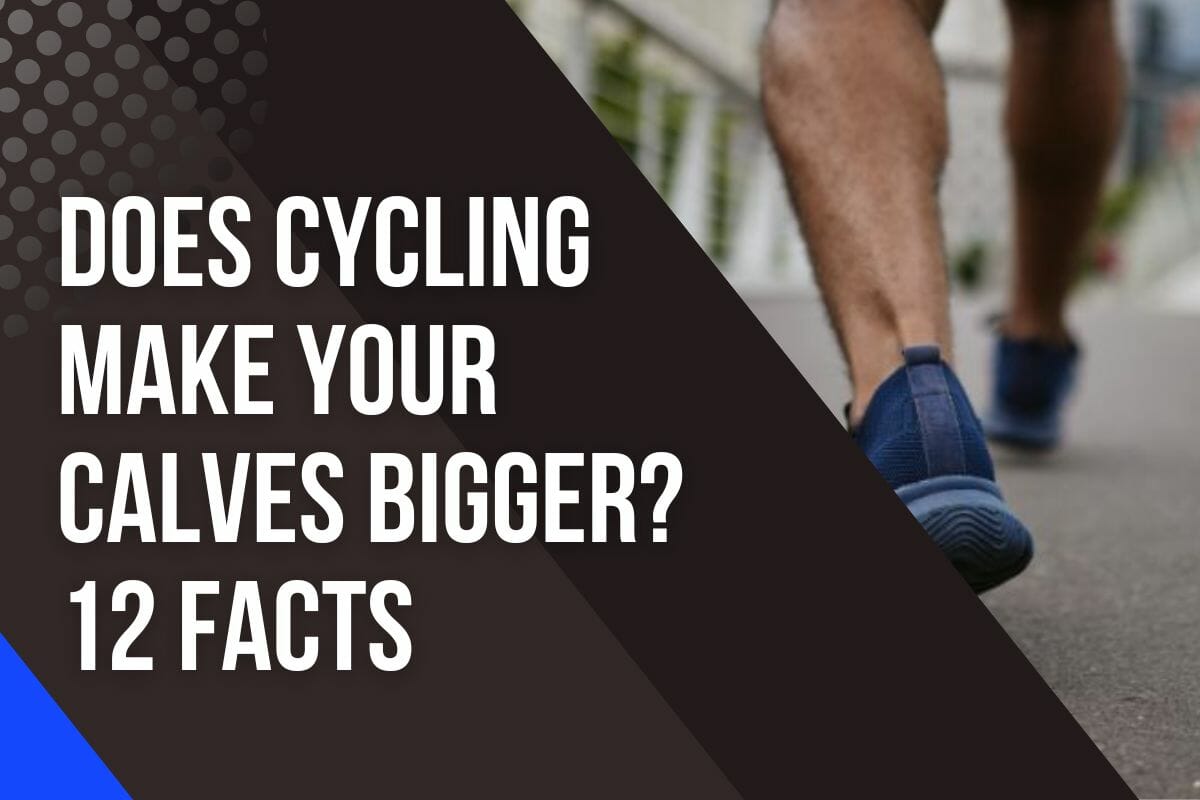12 Simple Ways To Stop Lower Back Pain When Cycling

Do you love cycling but find that it’s causing lower back pain? You’re not alone.
Lower back pain is a common complaint among cyclists, and it can be a real pain in the, well, back.
Fortunately, there are several simple ways to alleviate lower back pain when cycling.
By making a few adjustments to your bike and your cycling technique, you can keep pain at bay and enjoy your ride to the fullest.
In this article, I’ll share 12 easy tips to help you stop lower back pain when cycling.
Tips for Preventing and Relieving Lower Back Pain When Cycling
Experiencing back pain while cycling can be a frustrating experience. I’m learning it the hard way.
Fortunately, I have some practical tips to help reduce and prevent back pain.
Let’s get started.
1. Build Up Gradually
First and foremost, don’t rush into it! Gradually building up your training routine will give your body time to adjust and avoid overuse injuries.
Now, let’s talk about something crucial: core stability. If you want to avoid lower back pain while cycling, you need to work on strengthening your core.
A strong core will support your spine and help you maintain a healthy posture while riding.

When you’re just starting out, it’s best to focus on riding at a high cadence and low resistance.
This will allow your muscles to adapt gradually without getting overwhelmed. And remember, don’t push yourself too hard too fast.
Increase your training mileage by only 10% each week to avoid muscle fatigue and strain.
2. Get a Professional Bike Fit
Do not overlook the benefit of a professional bike fit.
During this process, a bike expert will carefully measure and adjust your bike to fit your body perfectly.
They’ll even ask about any pain you’re experiencing to find the root cause and make the necessary changes.
Trust me, an ill-fitted bike can lead to all sorts of discomfort and pain, like swinging hips or aching back and neck.

3. Regularly Stretching or Yoga
I recently experienced this firsthand when I started suffering from lower back pain while cycling, and I realized that it was due to a lack of stretching.
To combat this issue, I turned to the Yoga | Down Dog app, which allowed me to easily start my own customized stretching routine.
The app allowed me to select different music, poses, and instructors, as well as set a timer for however long I wanted (even just five minutes).
If you want to improve your flexibility and alleviate muscle tension without having to commit too much time each day, then this is an excellent option.

4. Address Your Anterior Pelvic Tilt
An anterior pelvic tilt is a common postural concern that many cyclists, especially those who ride frequently and do not properly warm up or cool down after their rides, may experience.
This occurs when the two hip bones of the pelvis are tipped forward from the neutral anatomical position, which can lead to lower back pain as well as other muscular imbalances.
So why does this happen? Besides cycling contributing to tight hip flexors and quads due to consistent pedaling action over time, these muscle groups become tighter than they should be.
This then pulls on our pelvis in an attempt to overcompensate for some imbalance, resulting in an anterior pelvic tilt posture.
Fortunately, regularly doing consistent exercises and stretching can help avoid postural problems such as this.

5. Get a Better Saddle
One of the simplest solutions for relieving lower back pain during cycling is to swap your saddle for one that provides better support for your pelvis.
There are numerous saddles available on the market, but it’s important to choose one that suits your needs and anatomy.
Women, for example, may benefit from wider saddles that accommodate their sit bones, as these can reduce pressure on soft tissues and nerves in the area.
One great option to consider is the Terry Bicycles Corta or Butterfly Century saddles.
These models are specifically designed with women in mind, featuring a cut-out center that relieves pressure and supports the sit bones.
For men, I personally use the Fly Ti Gel Saddle.
These saddles are made with high-quality materials and designed to reduce pressure points while providing reliable support, making them a great option for anyone looking to relieve lower back pain during cycling.
6. Use Wider Tires
The increased air cushion provided by wider tires absorbs some of the forces experienced while cycling, which can reduce the stress on the intervertebral discs of the lumbar spine.
This means that the impact and vibrations from the road are less likely to cause discomfort in your lower back.
According to Physio Phil Burt, his clients have successfully used higher-volume road bike tires to prevent and reduce lower back pain. Make sure to have the optimum road bike tire pressure.

7. Cross-train & Build Core Strength
We may be tempted to get out on our bikes every day, all day, but too much biking without any supplemental cross-training can lead to muscular imbalances.
And eventually result in back pain due to fatigue and overuse of the lower back muscles.
Exercises geared towards the development of abs and back muscles will assist in stabilizing the body when riding and make it easier for your legs and other muscle groups to do their job efficiently so that you don’t become fatigued as quickly.
There are many simple exercises you can do at home with little or no equipment.
I recommend using an app like Ultrahuman which provides many different workouts tailored towards building core strength specific for cyclists.
Try it out! You’ll see results almost immediately with improved stability on the bike, increased endurance, and fewer aches after rides.
8. Try an Inversion Table
An inversion table is an ideal piece of equipment for anyone looking to reduce their back pain, from bulging discs or not.
The way it works is by stretching and decompressing the vertebrae in your spine, and the associated muscles and tendons too.
I can personally attest to how much an inversion table helped me when my back was really bad a few years ago.

I invested in the Teeter FitSpine X3 model and it has been incredible for supporting my lower back while cycling.
Even just five minutes on the inversion table a day has made a massive difference with regard to how my back feels overall.
9. Use a Standing Desk
Another effective method to alleviate back pain caused by cycling is by using a standing desk.
As many office workers can attest, sitting at a desk for several hours at a time can lead to muscle tension in the quads and hip flexors, and eventually cause lower back pain.
Similarly, cycling requires a position that can be hard on the body, especially if the cyclist is not using a professional bike fit.
However, using a standing desk can help ease this pain by allowing you to change your body position and relieve muscle tension.

Instead of being locked in one position all day, a standing desk provides an option to stand up while working.
This, in turn, will allow your quads and hip flexors to relax and reduce lower back pain caused by cycling.
10. Get a Back Massager
Using a low back massager can be an excellent solution to help alleviate discomfort and tension. One highly-rated option is the TruMedic InstaShiatsu+ Neck and Back Massager.
This massager utilizes a combination of Shiatsu massage and heat therapy to deliver an effective and versatile solution for muscle soreness and fatigue.
Its unique design allows it to target not only the lower back, but also other areas of the body such as the neck, shoulders, and legs.
This versatility makes it an ideal option for athletes and those who suffer from different kinds of muscle pain.
11. Take Rest Days
Rest days give your body the opportunity to recover and repair itself, which is essential in preventing overuse injuries, including lower back pain.
Taking a short walk on your rest days can help to promote blood flow and reduce muscle tension, which can ease discomfort and help prevent further injury.

If your back pain persists the day after cycling or if it’s associated with pain running down one or both legs, it’s important to seek medical attention.
These types of symptoms could indicate a more severe injury, which may require professional medical treatment.
12. Get an MRI
An MRI can help identify the source of lower back pain by revealing any abnormalities and helping to provide an accurate diagnosis.
It’s important to note that an MRI is not always necessary and should only be undertaken on the advice of a qualified medical professional.
Your healthcare provider may recommend other diagnostic tests or treatments before an MRI, depending on the severity and nature of your lower back pain.

After an MRI, your healthcare provider will review the results with you and recommend appropriate recovery options based on your individual needs.
These may include physical therapy to help stretch and strengthen your lower back muscles, or rest and other forms of conservative treatment to reduce inflammation and promote healing.
Causes Of Cycling Lower Back Pain
Poor bike fit, lack of care off the bike, physical injuries & ailments, as well as too many weekly miles, are some of the common causes of lower back pain in cyclists.
Let’s take a closer look at each one.
Poor Bike Fit
Poor bike fit is a one of the most common causes of lower back pain in cyclists.
It can lead to all sorts of issues beyond just a sore back such as imbalances and leg length discrepancies.
For instance, if your saddle is too high, you might be overextending your leg, which can put way too much stress on your lower back.
And if your handlebars are too high, you might be putting undue pressure on your poor lower back, leading to some serious discomfort.
Not Taking Care of Your Back
Taking care of your body off the bike is just as important as ensuring proper bike fit when it comes to avoiding lower back pain.
This is maybe overlooked but one of the biggest issues that can make lower back pain worse is prolonged periods of sitting, such as at a desk.
When you sit for a long time, it can create muscle imbalances and cause hip flexors to become tight, leading to discomfort.
To counteract the effects of prolonged sitting and cycling positions, it’s crucial to incorporate back extension exercises and hip flexor stretches into your routine.
We’ll cover the exercises in detail in the last section of this article.
Physical Injuries
Some of the most common physical injuries and ailments that can cause back pain during or after cycling include herniated discs, spinal stenosis, muscle strains, tears, arthritis, and sciatica.
Herniated discs occur when one of the discs in the spinal column ruptures, causing the soft center portion to protrude and irritate surrounding nerves, resulting in back pain.
Spinal stenosis, on the other hand, occurs when the space around the spinal cord narrows, leading to nerve compression and back pain.
Muscle strains and tears can be caused by overuse, poor positioning on the bike, or sudden movements.
Arthritis can develop over time, and it can affect any joint in the body, leading to back pain.
Sciatica is another common cause of back pain during or after cycling, which results from irritation or compression of the sciatic nerve, leading to pain in the lower back and legs.
Cycling Too Much
Cycling too many weekly miles can take a toll on your back and increase the chances of developing back pain.
By increasing your mileage too quickly, you put unnecessary stress on your back muscles, risking injury. Instead, take a measured approach and give yourself time to adjust to the new demands.
What About Upper Back Pain?
Cyclists often deal with lower-back pain, but upper-back pain is also a common discomfort.
This can be caused by your riding position and technique, as well as poor posture during daily activities.
If you spend a lot of time in a drop handlebar position, you may be over-arching your back, leading to muscle tightness.
Weak upper-back muscles can also contribute to this pain.
Surprisingly, wearing a backpack while cycling can be a trigger, causing imbalances and muscle spasms.
To avoid making the issue worse, it’s best to leave your backpack at home. Your back will thank you for it.
Exercises to Avoid Back Pain from Cycling
Here are six exercises that you can add to your workout regimen to help keep your back pain-free: walking lunges, the cat stretch, the Bug, crucifix stretch, dynamic hamstring stretches, and thoracic extension stretch.
By incorporating these exercises into your routine, you can stretch and strengthen the muscles that support your back, allowing you to ride pain-free for longer periods.
Walking Lunges
Walking lunges are an effective form of exercise that targets the quads, core, and hip flexors. These are muscles that support your lower back and prevent pain from cycling.
To do a proper walking lunge, start by standing up straight with your feet shoulder-width apart.
Step forward with one foot, bending your ankle and knee to 90 degrees while keeping your weight on the back leg.
As you lunge forward, engage your core and clench your buttocks to maintain stability and maximize the benefits of the exercise. Repeat the lunge on the opposite side, taking a step forward and performing the same movement.
Aim to perform walking lunges for 3 sets of 15-20 reps each, taking breaks as needed to rest in between.
The Cat Stretch
The cat stretch is a simple yet effective exercise that targets the spine and core muscles, making it a great addition to any cycling routine.
To begin the cat stretch, kneel on all fours with your knees hip-width apart and your hands shoulder-width apart, keeping your wrists directly under your shoulders.
Picture yourself tilting your “bucket” forward and back, as if you were pouring water out of the front and back.
This movement is not only a great stretch for your spine but also targets those hard-to-reach deep core muscles.
When performing this exercise, repeat it little and often, rather than continuously for an extended period of time. Aim to perform the cat stretch for 1-2 minutes before taking a break.
Dead Bug
Dead Bug is effective because it targets the muscles in the tummy, reducing the strain on the back.
To perform “Dead Bug,” lie flat on your back with your arms straight up towards the ceiling. Bend your hips and knees so that they’re both at a 90-degree angle.
Your shins should be parallel to the floor.
Once you’re in this starting position, slowly lower your right arm and left leg while keeping the other arm and leg stationary.
Then, raise them back up and repeat with the opposite limbs. This motion can be repeated several times.
Crucifix Stretch
The Crucifix stretch is an excellent exercise that targets multiple muscle groups, including the lumbar spine, hip flexors, buttocks, back muscles, and hamstrings.
To start, lie on your back with your arms stretched out at right angles to your sides and both legs straight.
To perform this exercise, maintain contact between your arms and the floor throughout. Next, raise your right leg approximately 2 inches above the floor and swing it across your left leg as far as is comfortable.
To stretch your lower back and hips, alternate lifting each leg and aim to do two sets of 10 to 15 repetitions per leg.
Dynamic Hamstring Stretches
Dynamic hamstring stretches target multiple muscle groups, including the hamstrings, piriformis, tensor fasciae latae, and calf, making it an effective way to address back pain from cycling.
To start, stand with your feet together and take three small steps forward. Lean forward as you slide your hands down your leg towards the ankle. Repeat the same movement with your other leg in front.
For the second position, take three small steps forward with your front foot turned out. Sink into the lunge, ensuring your front knee is over your ankle. Repeat for 10-20 reps before switching to the opposite leg.
Finally, take three small steps forward with your front foot turned inward. Keeping both feet flat on the ground, lean forward and reach for your ankle. Repeat for 10-20 reps, ensuring to switch legs to target both sides evenly.
Thoracic Extension Stretch
The thoracic extension stretch is an effective way to promote mobility in the spine and chest. It involves lying on an exercise ball, or a rolled-up towel, along your back.
This exercise is easy to do at home by using an exercise ball or rolling up a small towel into a cylinder that is 10-15cm in diameter and then securing it with elastic bands so that it won’t unravel or slide around.
Once you have your prop safely secured, lie down on it, lining up your spine so that it’s extending from your neck all the way to mid-back.
Hold this posture for 15-20 minutes each day without forcing or pushing any further than what feels comfortable for you, and soon enough you will see improvements in both flexibility and strength.
Final Thoughts
Lower back pain while cycling can be a frustrating and painful experience, but there are steps you can take to alleviate and prevent it.
By following the tips outlined in this article, such as proper bike fit, stretching, and strengthening exercises, you can enjoy your rides without discomfort.
Remember, it’s important to listen to your body and make adjustments as needed. If the pain persists or worsens, it’s always a good idea to consult with a healthcare professional.
Ready to hit the road pain-free? Read our post on how to prevent injuries while cycling.





